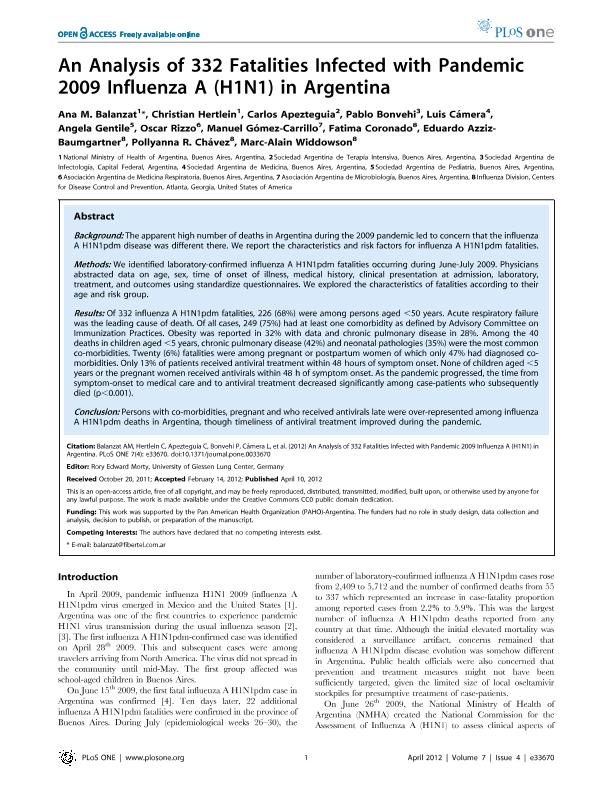Artículo
An analysis of 332 fatalities infected with pandemic 2009 influenza A (H1N1) in Argentina.
Balanzat, Ana M.; Hertlein, Christian; Apezteguia, Carlos; Bonvehi, Pablo; Cámera, Luis; Gentile, Angela; Rizzo, Oscar; Gómez Carrillo, Manuel ; Coronado, Fatima; Azziz Baumgartner, Eduardo; Chávez, Pollyanna R.; Widdowson, Marc Alain
; Coronado, Fatima; Azziz Baumgartner, Eduardo; Chávez, Pollyanna R.; Widdowson, Marc Alain
 ; Coronado, Fatima; Azziz Baumgartner, Eduardo; Chávez, Pollyanna R.; Widdowson, Marc Alain
; Coronado, Fatima; Azziz Baumgartner, Eduardo; Chávez, Pollyanna R.; Widdowson, Marc Alain
Fecha de publicación:
04/2012
Editorial:
Public Library of Science
Revista:
Plos One
ISSN:
1932-6203
Idioma:
Inglés
Tipo de recurso:
Artículo publicado
Clasificación temática:
Resumen
Background: The apparent high number of deaths in Argentina during the 2009 pandemic led to concern that the influenza A H1N1pdm disease was different there. We report the characteristics and risk factors for influenza A H1N1pdm fatalities. Methods: We identified laboratory-confirmed influenza A H1N1pdm fatalities occurring during June-July 2009. Physicians abstracted data on age, sex, time of onset of illness, medical history, clinical presentation at admission, laboratory, treatment, and outcomes using standardize questionnaires. We explored the characteristics of fatalities according to their age and risk group. Results: Of 332 influenza A H1N1pdm fatalities, 226 (68%) were among persons aged <50 years. Acute respiratory failure was the leading cause of death. Of all cases, 249 (75%) had at least one comorbidity as defined by Advisory Committee on Immunization Practices. Obesity was reported in 32% with data and chronic pulmonary disease in 28%. Among the 40 deaths in children aged <5 years, chronic pulmonary disease (42%) and neonatal pathologies (35%) were the most common co-morbidities. Twenty (6%) fatalities were among pregnant or postpartum women of which only 47% had diagnosed co-morbidities. Only 13% of patients received antiviral treatment within 48 hours of symptom onset. None of children aged <5 years or the pregnant women received antivirals within 48 h of symptom onset. As the pandemic progressed, the time from symptom-onset to medical care and to antiviral treatment decreased significantly among case-patients who subsequently died (p<0.001). Conclusion: Persons with co-morbidities, pregnant and who received antivirals late were over-represented among influenza A H1N1pdm deaths in Argentina, though timeliness of antiviral treatment improved during the pandemic.
Palabras clave:
pandemic influenza
,
AH1N1
,
Argentina
Archivos asociados
Licencia
Identificadores
Colecciones
Articulos(OCA HOUSSAY)
Articulos de OFICINA DE COORDINACION ADMINISTRATIVA HOUSSAY
Articulos de OFICINA DE COORDINACION ADMINISTRATIVA HOUSSAY
Citación
Balanzat, Ana M.; Hertlein, Christian; Apezteguia, Carlos; Bonvehi, Pablo; Cámera, Luis; et al.; An analysis of 332 fatalities infected with pandemic 2009 influenza A (H1N1) in Argentina.; Public Library of Science; Plos One; 7; 4; 4-2012; 1-10
Compartir
Altmétricas



